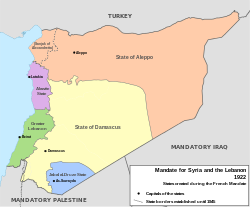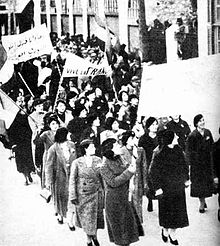Hatay State
Hatay State Hatay Devleti État du Hatay دولة خطاي | |||||||||
|---|---|---|---|---|---|---|---|---|---|
| 1938–1939 | |||||||||
 Flag | |||||||||
| Anthem: İstiklâl Marşı | |||||||||
 | |||||||||
| Capital | Antakya 36°25′49″N 36°10′27″E / 36.43028°N 36.17417°ECoordinates: 36°25′49″N 36°10′27″E / 36.43028°N 36.17417°E | ||||||||
| Common languages | Turkish (official) French (second) Levantine Arabic | ||||||||
| Government | Republic | ||||||||
| President | |||||||||
• 1938–1939 | Tayfur Sökmen | ||||||||
| Prime Minister | |||||||||
• 1938–1939 | Abdurrahman Melek | ||||||||
| Legislature | Hatay State People's Assembly | ||||||||
| Historical era | Interwar period | ||||||||
• Independence | 7 September 1938 | ||||||||
• Union with Turkey | 29 June 1939 | ||||||||
| Area | |||||||||
| 1938 | 4,700 km2 (1,800 sq mi) | ||||||||
| Population | |||||||||
• 1938 | 234,379 | ||||||||
| Currency | Turkish liraa | ||||||||
| |||||||||
| Today part of | Turkey | ||||||||
| |||||||||
Hatay State (Turkish: Hatay Devleti, French: État du Hatay, Arabic: دولة خطاي Dawlat Khaṭāy), also known informally as the Republic of Hatay, was a transitional political entity that existed from September 7, 1938, to June 29, 1939, in the territory of the Sanjak of Alexandretta of the French Mandate of Syria. The state was transformed de jure into the Hatay Province of Turkey on July 7, 1939, de facto joining the country on July 23, 1939.
History[]
Background[]
Formerly part of the Aleppo Vilayet of the Ottoman Empire, the Sanjak of Alexandretta was occupied by France at the end of World War I and constituted part of the French Mandate of Syria.
The Sanjak of Alexandretta was an autonomous sanjak from 1921 to 1923, as a result of the Franco-Turkish Treaty of Ankara, as it had a large Turkish community as well as its Arab and Armenian population. Then it was attached to the State of Aleppo, then in 1925 it was directly attached to the State of Syria, still with a special administrative status.[1]
Turkish leader Mustafa Kemal Atatürk refused to accept the Sanjak of Alexandretta as part of the Mandate and, in a speech on March 15, 1923 in Adana, he described the Sanjak as "A homeland where Turks lived for centuries and can't be a captive at the hands of enemy".[2] Turkish policy aimed at annexing the Sanjak of Alexandretta when the French mandate of Syria was due to expire in 1935. Turks in Alexandretta initiated reforms in the style of Atatürk's, and formed various organisations and institutions in order to promote the idea of union with Turkey.

In 1936, the elections returned two Syrian independentist MPs (favoring the independence of Syria from France) in the sanjak, and this prompted communal riots and passionate articles in the Turkish and Syrian press. In particular, Arab nationalist Zaki al-Arsuzi was influential.
In response, Atatürk government coined the name Hatay for the Sanjak of Alexandretta, as a reference to Hittites (Syro-Hittite states), and raised the "Issue of Hatay" (Turkish: Hatay Meselesi) at the League of Nations. On behalf of the League of Nations, representatives of France, the United Kingdom, the Netherlands, Belgium and Turkey prepared a constitution for the sanjak. The new statute came into power in November 1937, the Sanjak becoming 'distinct but not separated' from Syria on the diplomatic level, linked to both France and Turkey for military matters.[1]

On September 2, 1938, the sanjak assembly proclaimed the Sanjak of Alexandretta as the Hatay State. The State lasted for one year under joint French and Turkish military supervision.
On June 29, 1939, following a referendum, the Hatay legislature voted to disestablish the Hatay State and join Turkey. This referendum has been labelled both "phoney" and "rigged", as the Turkish government organised tens of thousands of Turks from outside Alexandretta to register as citizens and vote.[3] The French encouraged the annexation, hoping it would act as an incentive to Turkey to reject an alliance with Nazi Germany.[4]
Syrian President Hashim al-Atassi resigned in protest at the continued French intervention in Syrian affairs, maintaining that the French were obliged to refuse the annexation under the Franco-Syrian Treaty of Independence of 1936.
Legislature[]
The Hatay State People Assembly (Turkish: Hatay Devleti Millet Meclisi) consisted of 40 members, consisting of 22 Turks, nine Alawites, five Armenians, two Orthodox Greeks and two Sunni Arabs.
Annexation[]
On July 7, 1939, the Grand National Assembly of Turkey approved the law establishing the Hatay Province and incorporating districts from Adana Province (then Seyhan Province) and Gaziantep Province. By July 23, 1939, the last vestiges of the French Mandate authorities had left Antakya, and the territory was fully annexed by Turkey. The result was a flight of many Arabs and Armenians to Syria. The region's Armenian population, having been survivors of the Armenian genocide, had fled for their lives to the French Mandate of Syria and therefore weren't able to contemplate Turkish sovereignty.[5] Following the annexation, almost the entire Armenian population of Hatay had settled in Aleppo, with many others moving to Lebanon where they founded the modern town of Anjar near the ruins of its historic castle.
Population and demographics[]
According to the estimates of the French high commission in 1936, out of a population of 220,000 39% were Turks, 28% Arabic-speaking Alawites, 11% Armenians, 10% Sunni Arabs, 8% other Christians and 4% were Circassians, Kurds and Jews. Although Turks formed the largest single ethno-religious minority, Arabic speakers including Sunnis, Alawites and Christians were more numerous.[6]

| Population of Hatay State in 1936 according to the French census[6] | ||||||
| Ethnoreligious groups | Inhabitants | % | ||||
|---|---|---|---|---|---|---|
| Alawis | 61,600 | 28% | ||||
| Sunni Arabs | 22,000 | 10% | ||||
| Melkites, Greeks and other Christians | 17,600 | 8% | ||||
| Turks | 85,800 | 39% | ||||
| Armenians | 24,200 | 11% | ||||
| Circassians, Jews, Kurds | 8,800 | 4% | ||||
| Total | 220,000 | 100% | ||||
In popular culture[]
The Republic of Hatay is used in the film Indiana Jones and the Last Crusade as the location of the fictional Canyon of the Crescent Moon, the resting place of the Holy Grail.[7]
See also[]
References[]
- ^ Jump up to: a b Picard, Elizabeth (Spring 1982). "Retour au Sandjak". Maghreb-Machrek (in French). Paris: Documentation française (99).
- ^ "History of Hatay (In Turkish)". Antakyarehberi.com. Archived from the original on 2013-05-15. Retrieved 2012-06-19.
- ^ Robert Fisk (2007). The Great War for Civilisation: The Conquest of the Middle East (Paperback ed.). Vintage. p. 335. ISBN 1-4000-7517-3.
- ^ Jack Kalpakian (2004). Identity, Conflict and Cooperation in International River Systems (Hardcover ed.). Ashgate Publishing. p. 130. ISBN 0-7546-3338-1.
- ^ "ARMENIA AND KARABAGH" (PDF). Minority Rights Group. 1991. Archived from the original (PDF) on 3 September 2013. Retrieved 8 December 2014.
- ^ Jump up to: a b Brandell, Inga (2006). State Frontiers: Borders and Boundaries in the Middle East. I.B.Tauris. p. 144. ISBN 978-1-84511-076-5. Retrieved 30 July 2013.
- ^ Indiana Jones and the Last Crusade (1989) - IMDb, retrieved 2020-03-27
Sources[]
- Sökmen, Tayfur: Hatay'ın Kurtuluşu İçin Harcanan Çabalar, Ankara 1992, ISBN 975-16-0499-0.
- Dr. Abdurrahman Melek, Hatay Nasıl Kurtuldu, Türk Tarih Kurumu, 1966
External links[]
![]() Media related to Hatay State at Wikimedia Commons
Media related to Hatay State at Wikimedia Commons
- Former countries in the Middle East
- States and territories established in 1938
- History of Hatay Province
- 1939 in Turkey
- Syria–Turkey relations
- Former polities of the interwar period
- 1938 establishments in Asia
- 1939 disestablishments in Asia
- States and territories disestablished in 1939

